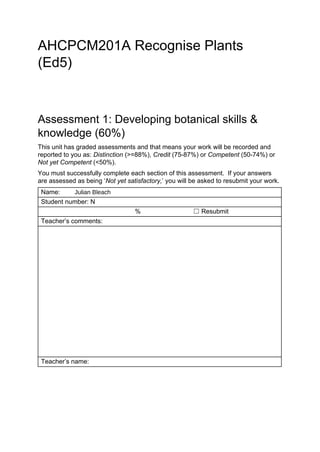4.
Part 1: Using the taxonomic system
1. Complete the table below then answer the questions that follow. You will find that
some of the species listed aren’t on your study list so you’ll need to do some
research for those. 30 marks
Common name Family Genus species
Rough Tree
Fern
Cyatheaceae Cyathea Cyathea australis
Norfolk Island
Pine
Araucariaceae Araucaria Araucaria
heterophylla
Burrawang Zamiaceae Macrozamia Macrozamia
communis
River Red Gum Myrtaceae Eucalyptus Eucalyptus
camaldulensis
London Plane
Tree
Platanaceae Platanus Platanus acerifolia
Weeping
Bottlebrush
Myrtaceae Melaleuca Melaleuca viminalis
Japanese Box Buxaceae Buxus Buxus microphylla
Mondo Grass Asparagaceae Ophiopogon Ophiopogon
japonicus
Bird of Paradise Strelitziaceae Strelitzia Strelitzia spp.
Sweet Pea Fabaceae Lathyrus Lathyrus odoratus
2. Why does the botanic name of the London Plane have an x in it? 3 marks
The x indicates it is a hybrid. It is the offspring of two different species, the
American sycamore (Platanus occidentalis) & the Oriental plane (Platanus
orientalis)
3. What do the letters var. in the name of the Japanese Box signify? 3 marks
Variety. To distinguish the subspecies type and their country of origin.
4. Botanic names are made up by botanists and they all mean something. For
example, in the Old Man Banksia, Banksia serrata, the genus commemorates Sir
Joseph Banks and the specific epiphet shows that it has serrated leaf margins.
LA018996 Assessment 1 – Developing botanical skills & knowledge AHCPCM201A Ed 5
© New South Wales Technical and Further Education Commission, 2015 (TAFE NSW – WSI), Version 1, March 2015
Great work here. Notes: Family names are written in upper case. Just letting you know for future reference.
Correct
Correct
5.
Do some research and then in your own words explain the meaning of the botanic
names of: 2 mark each x 2 = 4marks
River Red Gum: Eucalyptus camaldulensis Of the genus Eucalyptus, the
species was named after a private estate garden, Camaldoli Garden in Naples,
Italy where the specimen first came to be described.
Weeping Bottlebrush: Melaleuca viminalis Of the genus Melaleuca, the species
name viminalis is derived from the Latin word vimen meaning “osier” or “pliant
twig” referring to the weeping habit of the branchlets.
5. Beginning at the taxon Class, use the taxonomic scale outlined in your learning
resource to categorize the species in the two right hand columns:
2.5 marks each x 2 = 5 marks
Example Shore Juniper Coast Rosemary
Class: Angiospermae Pinopsida Eudicot
Subclass:
Dicotyledons
Pinophyta Angiosperm
Order: Proteales Pinales Lamiales
Family: Proteaceae Cupressaceae Lamiaceae
Genus: Banksia Juniperus Westringia
Species: serrata Juniperus conferta Westringia fruticosa
6. In your own words explain the meaning of the term: 5 marks
Cultivar (Cv): A plant variety that has been intentionally manually produced in
cultivation by the process of selective breeding and propagation in order to
achieve specific qualities.
LA018996 Assessment 1 – Developing botanical skills & knowledge AHCPCM201A Ed 5
© New South Wales Technical and Further Education Commission, 2015 (TAFE NSW – WSI), Version 1, March 2015
Note:: This plant is called Callistemon (for your reference)
Well answered here.
Correct.
6.
Part 2: Plant Morphology
1. Photograph or draw a small, mature dicot plant and label the following plant parts:
10 marks
● Tap root
● Lateral roots
● Stem
● Side shoots
● Two nodes
● One internode
● Axillary bud
● Leaf (name the leaf shape)
● Terminal bud
● Inflorescence (name the inflorescence type)
NB: You could use a weed like Petty Spurge or Flickweed but if you’re
photographing it you’ll need to remove it from the soil with roots intact, clean off
any remaining soil and photograph it on a sheet of white paper.
LA018996 Assessment 1 – Developing botanical skills & knowledge AHCPCM201A Ed 5
© New South Wales Technical and Further Education Commission, 2015 (TAFE NSW – WSI), Version 1, March 2015
8.
2. Summarise the typical differences between Monocotyledons (Liliopsida) and
Dicotyledons (Magnoliopsida) using the following headings table: 10 marks
Monocotyledons Dicotyledons
Number of
flower parts
Multiples of Three Multiples of Four or Five
Leaf
venation
Parallel Reticulated
Root system Adventitious Develop from radicle
Vascular
vessels
Bundles attached Bundles in a ring
2. Find an example of each of the following leaf shapes on a live plant. Take a clear
photograph of each and label it with the correct shape and botanic name of the
species. 13 marks
● Acicular
● Linear
● Lanceolate
● Ovate
● Elliptical
● Cordate
● Reniform
● Palmately lobed (Palmatifid)
● Pinnatisect
● Trifoliolate
● Palmate
● Pinnate
● Bipinnate
LA018996 Assessment 1 – Developing botanical skills & knowledge AHCPCM201A Ed 5
© New South Wales Technical and Further Education Commission, 2015 (TAFE NSW – WSI), Version 1, March 2015
Correct
